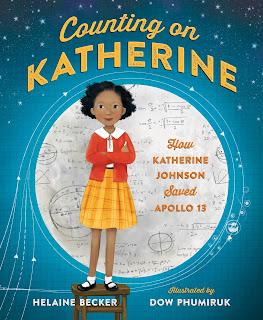I had the great pleasure of working with illustrator Dow Phumiruk on Counting on Katherine: How Katherine Johnson Saved Apollo 13, which "launched" earlier this summer.
Dow's artwork, in my opinion, is stunning, and really brought the book to the next level. I was curious as to how she blended her knowledge of math and science with her artwork to create such effective illustrations. So I asked her.
Here is the result of that interview:
H: Your artwork in Counting
on Katherine is so beautiful. But it's more than that - I can tell that it's
historically accurate too. Can you describe your process - how did you research
the illustrations in Counting on Katherine?
D: So much research!!
I started with
online sources from NASA. I also watched online interviews with Katherine
Johnson herself, which I found to be the most helpful to learn about her
personality. I read about the start of NASA, about the solar
system. I filled a folder on my computer with screenshots of images I
thought might be useful for reference. I read the Hidden Figures narrative
nonfiction book by Margot Shetterly (the movie did not come out until after my
final art was turned in). I made trips to the library to look through books
about space. I also looked at maps and images of what West Virginia looked like
in the 1930s, including the Greenbrier Inn in her hometown, and
what her classrooms might have looked like back then. I looked at online
clothing ads and patterns as well as old photographs to see what
styles of clothing best represented the fashion of each phase of her life. And
of course, I found as many photographs of Katherine herself at different ages.
H: What were the biggest challenges? Biggest surprises?
D: The biggest challenge was the above-described quest for accuracy, from the math to the scenery from her childhood. It was really difficult to find enough photo reference from that long ago. Little details were hard to discern, like if her family might have owned a car upon moving to Institute, West Virginia. In addition, her achievements spanned decades, and this meant learning as much as I could about the evolution of our space program over this long period of time.
I was surprised about
Katherine in general. I didn't know who she was upon receiving the pitch for
this project. I couldn't believe I had not heard of her before. The more I
learned about her life, the more I grew inspired!
H: The endpapers are stunning. They show a blackboard covered with mathematical equations and math problems. How did you, a)think to do this for the book, and b) come up with the material to put on the board?
 D: I wanted
to represent Katherine's genius with math-filled chalkboards.
Picturing her as a young girl in front of these chalkboards made sense to
emphasize the extent of her abilities since early childhood.
D: I wanted
to represent Katherine's genius with math-filled chalkboards.
Picturing her as a young girl in front of these chalkboards made sense to
emphasize the extent of her abilities since early childhood.
Coming up with the
information to fill the chalkboards was not easy! I may have been
proficient at math in my youth, but now advanced math is a challenge. Basic
algebra and word problems, like the picnic pies and the rocket ship
questions, are not a problem for me to make up. I was able to easily google
search equations for circumference, radius, volumes of different shapes for
example, to make up the ice cream cone question (in which I do not clarify
is the volume of the parts of a one scoop cone, by the way!). Sometimes,
as for the rocket ship trajectory question, I’d leave off needed
information to answer the question (so that I wouldn't need to have an
answer!).
I used multiple
sources for the rest and especially for the higher level math and physics seen
in the book. I got lots of help from my family, sampling bits from my
girls' homework (their work spanned algebra to calculus) and basic physics
equations from my husband’s old physics book (he is a former engineer). I
also found some information online, altering the source by
replacing letters and figures so it would not be just copied. In
compiling this together to fill the board, I would sometimes
intentionally obscure parts.
In the end, I would
remind myself that this is a book about a mathematician and her brilliance and
not a math textbook to keep myself from hyperventilating.
What projects are you working on now???




1 comment:
Thank you for having me here! I love the title you chose for this post.
Post a Comment